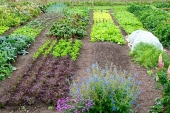I understand this wouldn't really be plausible on a large scale, but I just walk up to the victim plant, look for the bindweed stem where it's closest to the ground, and snip it with my fingers.
The dead bindweed still coils around my plant, but it's not going to do any more damage. In fact, in places where the bindweed hops from plant to plant, it can actually stabilize things, making the group stronger.
But yes, it does pull plants down. Nature's way of making compost for itself. Almost like the plant form of
mushrooms in that they are earth's teeth.
It's almost like plants know where other plants are in relation to it and will actively shade out or pull down things that don't compute. I noticed this also when I saw a single clover plant stretching it's body to purposely shade out my soon-to-be gigantic patty-pan squash. Just a friendly way of saying "I'm here with all my clover friends, and I don't want you in my sandbox".
As for bindweed, it's worth re-mentioning what was said in the podcast, the long tap-roots that are providing something great for the soil.
William





 1
1










 1
1













 1
1








 1
1











